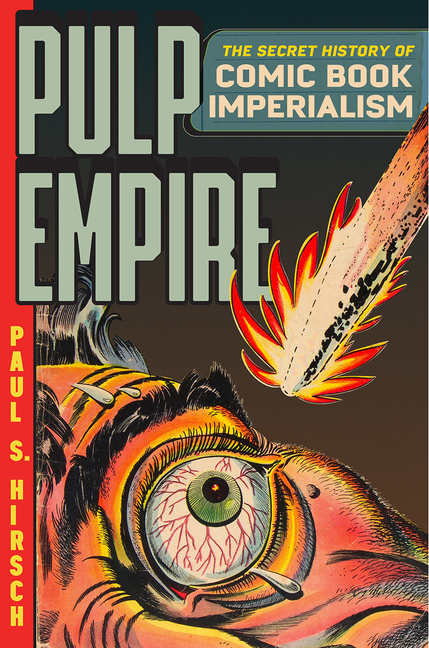[ad_1]
“We really do live in a pulp empire,” says Dr. Paul S. Hirsch. A chance discovery in an unlabelled box of federal documents led him to unearth a vast government plot to weaponize comic books. While this sounds like a pulp comic plot itself, Dr. Hirsch has produced Pulp Empire, a nonfiction work that is as startling in its discoveries as it is lurid in its illustrations, culled from pulp magazines of the 1940s and ‘50s.
I spoke with Dr. Hirsch over the phone to discuss Cold War propaganda, Marvel summer blockbusters, and the government’s pornography collection.
This interview has been edited for brevity.

Patrick Brennan
First of all, I’d like to say that while this book touched on a lot of dark material, it was really fun to read. What part of researching and writing Pulp Empire was most fun for you?
Paul S. Hirsch
I think the most fun was discovering something new in the archives. The first time I opened a particular box of records for an agency called the Writers’ War Board, I got so worked up I stood up and did laps around the table! Then I sat back down and realized there was page after page of evidence that the federal government played a huge role in shaping the comic book industry during World War Two— that comics were more than wildly popular entertainment, they were state-sanctioned propaganda. As I dove deeper into that box, it became clear to me that the purpose of this propaganda was to shape popular perceptions of race and to present the U.S. as this positive egalitarian country.
You know, there are no boxes in the government archives that are labelled “The federal government’s secret use of comics for propaganda.” So I just had to go through thousands of boxes that I thought might’ve had something to do with comics. And there was always this charge of excitement when I had found something particularly transgressive and problematic, because I knew someone in the government had bothered saving this, and it really agitated them. You know, I’d open a box in the Library of Congress and just find it full of vintage pornography, huge piles of old smut, and you’re not expecting to find that the government has saved stuff like that. But they did, and it was always kind of hilarious to come across a box like that.
Patrick Brennan
You say you found proof that the Writers’ War Board influenced the development of comic book culture. How did they communicate their directives to publishers?
Paul S. Hirsch
Beginning in 1943 they sent letters to the seven or eight biggest publishers of comics. As best I can tell, all but Timely, which is now known as Marvel, responded and agreed to participate. The first thing that the Writers’ War Board tells the publishers is, “Stop showing Germans as good. There can’t be any distinction between Nazis and Germans. They’re all bad, and the only solution to this is to exterminate as many of them as we need to.”
After that they start looking at images of Japanese characters. Even as early as 1943, people at the Writers’ War Board understand that this war might go on for a long time and that Americans have to be conditioned to this total war effort that might last many more years in the Pacific. So they encourage writers to publish stories with absolutely hateful, deeply racist imagery about all Japanese characters. I can think of one situation in which a comic book editor writes a plot that includes a Japanese woman who is a part of the anti-fascist resistance in Japan, and the Writers’ War Board immediately gets back to the editor and says, “You can’t print this story; readers have to be conditioned to hate all Japanese people. There’s no such thing as a good Japanese person as far as we’re concerned.”
So on one hand, the War Writers’ Board is using comics to generate race-based hatred against America’s enemies. On the other, very confusingly, they’re simultaneously trying to use comics to generate some kind of racial tolerance on the home front. But this is not soaring propaganda that’s shouting from the rooftops that the races are equal, this is really low level stuff. Really all they’re looking for through these comics is to keep things calm. They don’t want racial strife causing interruptions to war production, they don’t want race riots to make the U.S. look bad internationally, so they’re trying to use comics to tamp down racial tensions at home. They are not promoting equality, they’re just trying to keep people calm enough to win this war.
Patrick Brennan
It’s really shocking to see such a clear statement from an office of the government that’s weaponizing race relations and maintaining a status quo.
Paul S. Hirsch
It’s absolutely shocking. And that’s what caused me to stand up and take those laps around the table, because there’s nothing hidden about it, there’s nothing subtle about it. It’s right there, on page after page.
Patrick Brennan
Did these old comics make you look at any ways we encode racism and cultural supremacy today that will be similarly shocking to future readers?
Paul S. Hirsch
Absolutely—when the government and private companies continue to participate in this military entertainment complex. A few years ago, Marvel Comics was planning to team up with Northrop Grumman, which is an enormous defense company, and the supposed plan was to encourage STEM education through comic books. But when Marvel announced this, they were shocked by a backlash among the general public and the comic book community of people who were outraged that Marvel would lend the credibility of what are the most popular cultural characters on earth right now, their cast of superheroes, to an effort by a defense company to sort of worm its way into popular culture. They abandoned the idea, but that doesn’t mean it’s gone away. It just means the next time a comic book company won’t be so quick to publicize its cooperation with a defense contractor or a federal agency. I think that’s probably the lesson that Marvel extracted from this— not necessarily that collaboration is wrong, but that overt collaboration will get you into trouble.
This is not a topic that I’ve researched in real depth like I did [with] comic books, but the Pentagon is definitely involved with film production too. It provides taxpayer-funded equipment to film studios in exchange for script approval or assurances that the military will be portrayed positively in the finished film. This is not new, it’s been going on for decades and it’s very real, and I feel like it’s as insidious as the government’s co-optation of comic books. I would also be shocked if the military isn’t using first-person shooting games as recruitment and training tools. I worked very briefly at the Los Alamos National Laboratory back in 2006, I think, and some of the people working next to me were creating video games to help the government figure out ways in which enemies in the United States might attack nuclear installations. The way they did this was by turning it into a game, and I remember being blown away by that at the time- that the government was turning something so serious into a game.
Patrick Brennan
On the flipside of this overt propagandization, you also write about the emergence of what you called “implicit critiques of American society” that portray America as full of crime, violence and inequality. Where do we see these types of critiques today?
Paul S. Hirsch
I don’t think there are any critiques of American society right now that are as widely available as comics were back in the midcentury. Comics, no matter how violent or transgressive or anti-American, were available to anyone with a dime. They were in supermarkets, local stores, lying around on public transportation. I remember watching a video of an atomic test in Nevada, and some of the guys in that trench are reading comics! They’re waiting for an atomic bomb to go off and they’re still reading comics. Comics were everywhere. They were prevalent in a way we can’t really visualize now. And they were uncensored, so they were free to show images and tell stories that would never make it into movies or TV or radio.
Comics were everywhere, and at the same time they were also nowhere. They were invisible to vast portions of American society who just dismissed them as childish entertainment, yet they were absolutely pervasive in the United States and globally at the mid-twentieth century. And the government promoted the consumption of comic books. They sold the comics on military bases, they sent them to soldiers fighting World War Two, and after World War Two this enormous chain of military bases springs up literally around the world, and on any of those bases you can buy comics. So when we talk about comic books in the mid-twentieth century, it couldn’t be more different from what they are now, which is of secondary importance to the characters they spawned who are now on film.
Patrick Brennan
You mentioned that today’s blockbuster Marvel films are the descendents of these comic books. Are there any traces of that legacy of Cold War propaganda that viewers can look out for today?
Paul S. Hirsch
Twentieth century comics exist as ghosts among us. The excitement, the trauma, the rage generated by this swirl of uncensored comic books that travelled the world during the ‘40s and ‘50s continue to do cultural work in the United States and other countries. When someone from Sri Lanka or Brazil or China goes to watch a Marvel movie, they’re presented with characters that were created during World War Two, or at the peak of the Cold War, to support the American project, to support the idea that the United States was both better and more deserving of allies than the Soviet bloc, than communism, than fascism.
The easiest example for me to think of is Captain America. He’s the most moral, the most positive, the most endearing Avenger, and his name is Captain America! He was created during World War Two by a Jewish writer as a tool of anti-fascism, and that same spirit infuses Captain America when people sit down to watch Marvel movies today. So I think the reverberations are still very much with us. They’re also with us with Iron Man, this sort of military industrial complex turned into a human. He is humanity weaponized, he is the ultimate expression of American technological prowess, and he was created by Marvel comics, not with government intervention, but after the government forced the creation of a comic censorship code back in 1954.
So these are not characters that just sprung out of writers’ minds. That was a huge revelation to me when I was researching this book. I thought that a lot of the racism and violence and patriotism in the comic books was just reflexive, and some of it certainly was. But on the other hand, a lot of these violent and racist expressions that appear in comic books are there in one way or the other because the federal government was involved in the comic book industry. So when I talk about the ghosts among us and say that the cultural reverberations of these characters are still felt, this is what I mean. When you’re looking at these characters up on the screen, they have been adapted and updated, but at their core these are products of the American imperial project in the mid-twentieth century.

Nonfiction
Pulp Empire: The Secret History of Comic Book Imperialism
By Paul S. Hirsch
University of Chicago Press
Published July 12, 2021

[ad_2]
Source link
